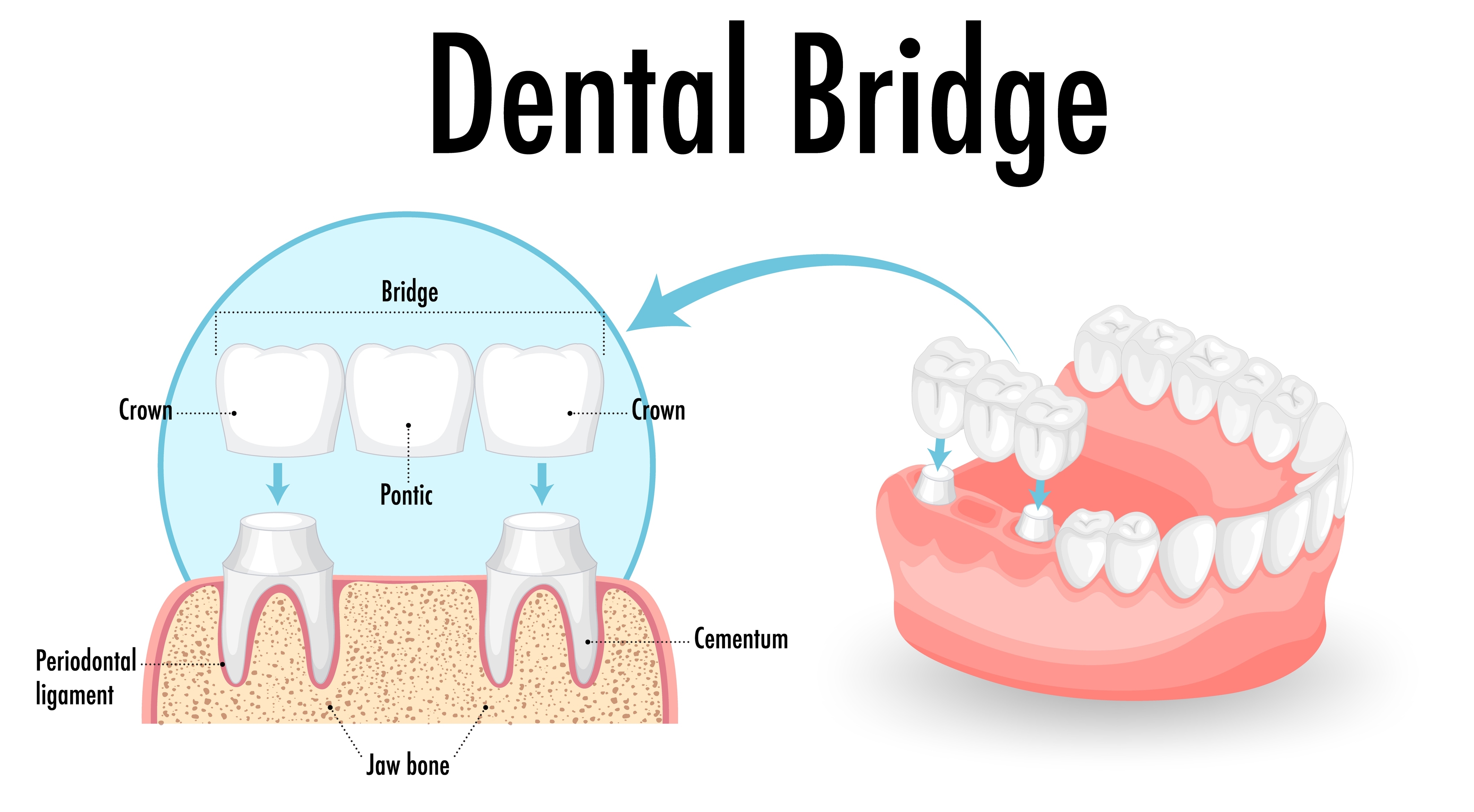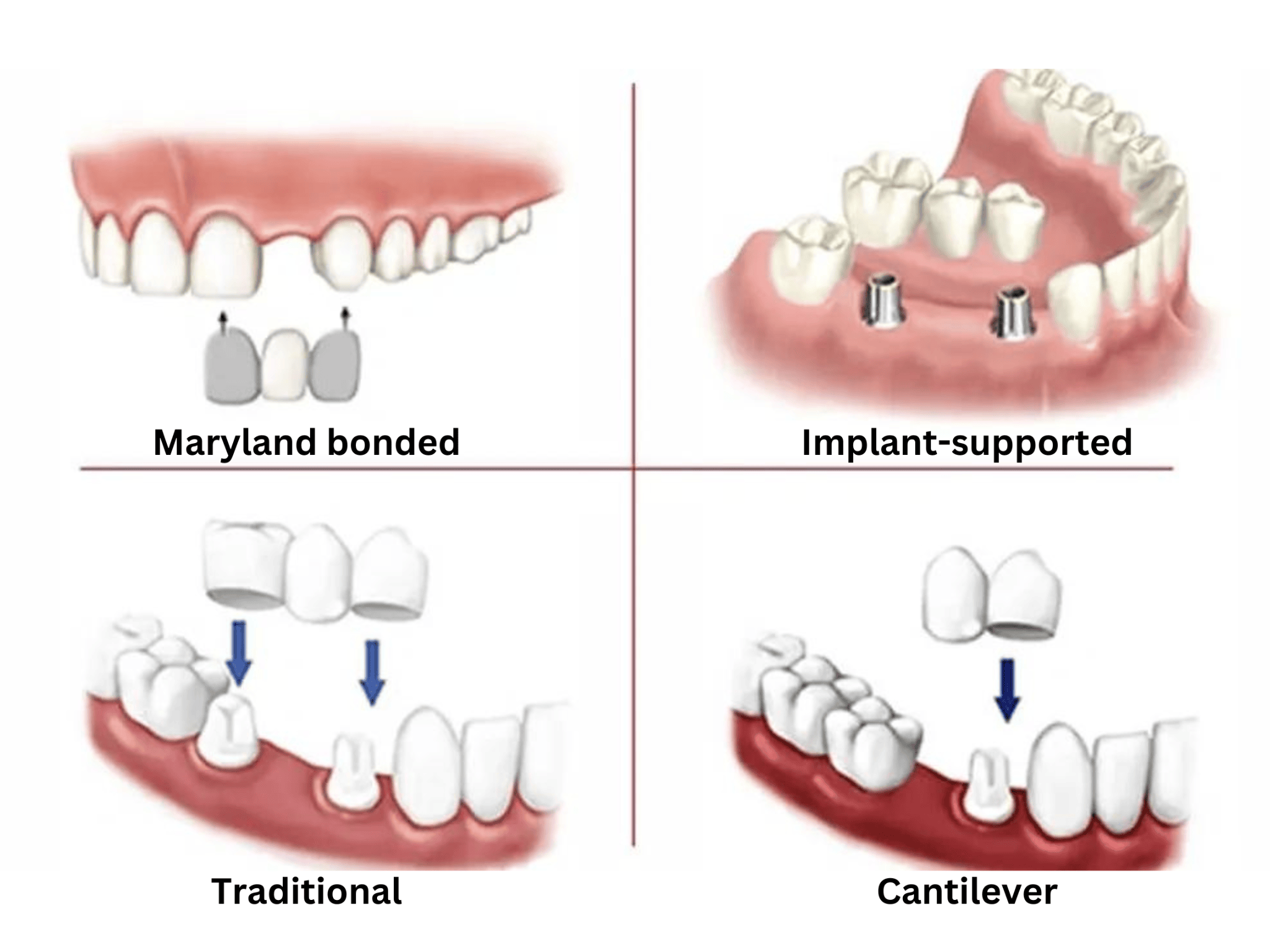What is a dental bridge?
A dental bridge is a restorative dental device used to replace one or more missing teeth. They consist of two main components:
- the pontic (the artificial tooth or teeth) and
- the abutments (the crowns attached to the natural teeth on either side of the gap).

What are the types of dental bridges?
There are several types of dental bridges, each designed to suit specific needs based on the patient's dental condition and preference.
- Traditional bridges
- Cantilever bridges
- Maryland bonded bridges (Resin-bonded bridges)
- Implant-supported bridges
Traditional bridges
This consists of one or more artificial teeth (pontics) attached to and held in place by dental crowns, which are cemented over the two natural teeth adjacent to it. This is the most common type of bridge used.
Cantilever bridges
Cantilever bridges involve only one adjacent supporting tooth, unlike the traditional bridge. The pontic (artificial tooth) is held in place by a single dental crown cemented over the adjacent supporting tooth. Cantilever bridges are traditionally used only when one tooth is missing and are often used in replacing a missing front tooth.
Maryland bonded bridges (Resin-bonded bridges)
These bridges use a metal or porcelain framework with wings on each side that are bonded only to the backside of the adjacent teeth, instead of the adjacent teeth being completely covered with a crown. This is a more conservative approach compared to other types of bridges and are typically used for replacing front teeth.
Implant-supported bridges
Instead of using adjacent natural teeth for support, these bridges are anchored to dental implants surgically placed in the jawbone. They are a viable option when multiple adjacent teeth are missing.
Each type has its advantages and considerations. Your dentist will assess your specific situation and recommend the most suitable type of bridge for you based on factors such as the location of the missing tooth/teeth, your oral health, and personal preferences.
What are the choices of material available?
Dental bridges can be made from various materials, each with its advantages in terms of aesthetics, strength, and durability. Some common materials used for dental bridges include:
All-metal (usually gold or alloy)
These bridges are highly durable and less prone to chipping or cracking compared to other materials. They are often used for molars or in areas where aesthetics is less of a concern.
Porcelain fused to metal (PFM)
These bridges combine the aesthetics of porcelain with the strength of metal. A metal framework is covered with porcelain, providing both durability and a natural appearance. However, the metal portion may sometimes be visible at the gumline.
Porcelain
Porcelain bridges provide a natural appearance and can be matched to the colour of your natural teeth. They are stain-resistant and biocompatible, making them a popular choice for visible areas of the mouth.
Zirconia
Zirconia bridges offer exceptional strength and durability while maintaining a natural appearance. They are highly resistant to chipping and are a popular choice for both front and back teeth.
The choice of material often depends on various factors, including the location of the bridge in the mouth, aesthetic preferences, and the patient's specific dental needs.
Dental bridge procedure: What can you expect?
- Initial examination and consultation:
- Your dentist will conduct a thorough examination of your oral health, including X-rays, to evaluate the condition of the missing tooth/teeth and the surrounding teeth and gums. They will discuss your options for a dental bridge based on your specific situation.
- Tooth preparation:
During the first visit for bridge placement, the adjacent teeth (abutment teeth) are prepared to support the bridge. This involves the removal of a portion of enamel from these teeth to make room for the dental crowns that will hold the bridge in place.
Impressions:
Once the teeth are prepared, impressions (moulds) of your teeth are taken. These impressions are sent to a dental laboratory, where the custom bridge, including the pontic and crowns, will be fabricated.
Temporary bridge placement:
- While the permanent bridge is being created in the dental lab, your dentist may place a temporary bridge to protect the exposed teeth and gums.
- Fitting the permanent bridge:
- Once the custom bridge is ready, you'll return to the dentist for the fitting. The dentist will check the fit, shape, and colour of the bridge to ensure it matches your natural teeth properly. Adjustments may be made as needed.
Final placement:
- Once satisfied with the fit and appearance, the permanent bridge is cemented or bonded into place. The dentist will secure the crowns onto the prepared teeth on either side of the gap, anchoring the bridge securely.
Post-placement care instructions:
Your dentist will provide instructions on how to care for your new bridge, including proper oral hygiene practices, such as regular brushing and flossing. Follow-up appointments may be scheduled to ensure the bridge is functioning correctly and that your gums and surrounding teeth remain healthy.
It is essential to maintain good oral hygiene and attend regular dental check-ups to ensure the longevity and proper function of your dental bridge.
Cost and financing
How much is a dental bridge in Singapore?
The cost can range from SGD 600 to SGD 3000 per tooth or more, depending on various factors. Public institutions like polyclinics may charge less, but private clinics often have shorter waiting times.
Can I use MediSave/CHAS to pay for dental bridges?
- For dental bridge procedures, CHAS subsidies are not available. Additional details on CHAS subsidies can be found here.
- MediSave covers part of dental treatment bills, which involve surgical procedures.
FAQ
How long do dental bridges last?
On average, a well-maintained dental bridge can last anywhere from 5 to 15 years or even longer.
Factors influencing the lifespan of a dental bridge include:
- Material:
- Different materials have different durability. Porcelain-fused-to-metal bridges are sturdy, while all-ceramic bridges are more aesthetically pleasing but may be slightly less durable.
Oral hygiene:
- Good oral hygiene is crucial for the longevity of a dental bridge. Proper brushing, flossing, and regular dental check-ups can prevent decay and gum disease that could compromise the bridge.
Chewing habits:
Chewing hard or sticky foods can put more stress on the bridge, potentially shortening its lifespan.
Fit and placement:
A well-fitted bridge placed by a skilled dentist is less likely to encounter issues.
Overall oral health:
- The health of the supporting teeth and gums plays a significant role. Any underlying issues can affect the bridge's stability and lifespan.
We recommend having regular dental check-ups to monitor the condition of the bridge and address any concerns promptly to extend its lifespan.
Does getting a dental bridge hurt?
The process of getting a dental bridge typically involves several visits, and while there may be some discomfort, especially during the preparation of the abutment teeth, any pain should be minimal and manageable with local anesthesia. It is essential to communicate openly with your dentist about any concerns or anxieties you may have, as they can help ensure your comfort throughout the procedure. After the procedure, you may experience some mild soreness or sensitivity, but this typically resolves in a few days as you adjust to the new dental bridge. If you have specific concerns about pain or discomfort, it is recommended to discuss them with your dentist before the procedure.
Dental bridge vs implant: Which is better?
Both dental bridges and dental implants are common solutions for replacing missing teeth, but they differ in several aspects, including:
| Dental bridge | Dental implant | |
| Procedure | Involves preparing adjacent teeth to support the bridge. The prosthetic tooth (pontic) fills the gap between the supporting teeth. | Involves surgically placing a titanium post into the jawbone to act as an artificial tooth root. A crown is then attached to the implant. |
| Cost | Generally, less expensive than a dental implant, although costs can vary based on the type of bridge and materials used. | Tends to be more expensive due to the surgical procedure and the materials used. |
| Impact on adjacent teeth | Adjacent teeth need to be altered (reduced in size) to accommodate the bridge. | Adjacent teeth are not affected, as the implant is placed directly into the jawbone. |
| Longevity | Typically lasts 5 to 15 years or more with proper care. | Can last a lifetime with proper maintenance and good oral hygiene. |
| Bone health | Does not prevent bone loss. Over time, the bone in the area of the missing tooth may deteriorate. | Helps preserve jawbone density by stimulating bone growth and preventing bone resorption. |
| Maintenance | Requires special flossing techniques and diligent oral hygiene to clean underneath the bridge. | Can be cared for like natural teeth, with regular brushing, flossing, and dental check-ups. |
| Aesthetics and function | Restores appearance and function but might not feel as natural as an implant. | Mimics the look, feel, and function of a natural tooth more closely. |
Each option has its advantages and disadvantages, so discussing these factors with your dental professional is crucial in determining the most suitable option for you.
How long can you wait to get a dental bridge?
For a case of recent tooth extraction, the average waiting time would be 4-6 weeks. This waiting time allows your gums and the extraction socket site to heal sufficiently and may vary depending on each individual.
For an old extraction space, preparation may begin as soon as there is sufficient space, and the adjacent teeth are ready to be modified into abutments.
Can a dental bridge be removed and recemented?
Yes, dental bridges can be removed and/or recemented. Care will be taken to preserve the underlying pontic.
What are the disadvantages of dental bridges?
While dental bridges can be an effective solution for tooth replacement, they also have some disadvantages:
- Preparation of adjacent teeth:
The teeth adjacent to the missing tooth space need to be prepared (reduced in size) to support the bridge. This process involves removing some enamel, which can weaken otherwise healthy teeth.
Risk of decay and gum disease:
- Dental bridges are fixed appliances and cleaning underneath them can be challenging. This increases the risk of decay or gum disease if proper oral hygiene isn't maintained.
Potential for damage:
- Bridges can be damaged by certain foods or habits like chewing on hard objects or ice. Damage could require repair or replacement.
Bone loss:
Missing teeth can lead to bone loss in the jaw over time. A bridge doesn't address this issue as dental implants might, as implants stimulate the jawbone and prevent bone resorption.
Dependency on adjacent teeth:
- If one of the supporting teeth for the bridge gets damaged or requires treatment, it can affect the entire bridge structure.
For more information, contact us:
Thomson Dental Centre
Call: 6255 0770
WhatsApp: 8716 9594
Book an AppointmentDr Charlotte Goh
Dentistry
Thomson Dental Centre (Novena Specialist Center)
English
AIA Dental PPO, Alliance MediNet, IHP, Inova Care and 2 others


